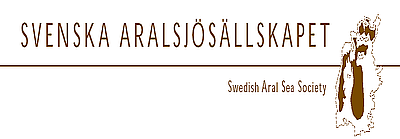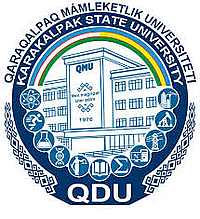Välkommen till Svenska Aralsjösällskapet
1b.
The UN process – from Stockholm to Johannesburg
The global society has been concerned about the development and how it relates to the state of the environment since the Stockholm United Nations Conference on The Human Environment in June 1972. At the Stockholm conference, environmental concerns were for the first time established on the world agenda. It had been present in several national policies before that, but at the Stockholm meeting it was clear that environment was an international concern for the simple reason that pollution and resource depletion does not respect national borders. Pollutants travel with water or air long distances. Not the least, the Baltic Sea Region countries had experienced that from the acid rain, mostly coming from continental Europe and the British Islands.
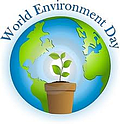 The Stockholm conference led to a major strengthening of the environmental agenda in many countries, with the establishment of ministries of environment, environmental protection agencies and the United Nations Environmental Protection Agency, UNEP. The 1970s also saw a remarkable strengthening of environmental science, environmental law, and the banning of the most destructive chemicals in many countries. Since the Stockholm conference, June 5 is celebrated as the World Environment Day (see also Chapter 9a: Governance and Democracy).
The Stockholm conference led to a major strengthening of the environmental agenda in many countries, with the establishment of ministries of environment, environmental protection agencies and the United Nations Environmental Protection Agency, UNEP. The 1970s also saw a remarkable strengthening of environmental science, environmental law, and the banning of the most destructive chemicals in many countries. Since the Stockholm conference, June 5 is celebrated as the World Environment Day (see also Chapter 9a: Governance and Democracy).
If the early 1970s had been a time favourable for international cooperation and a “fairly mild” Cold War, the global atmosphere in the early 1980s was one of distrust and confrontation. The introduction of medium distance nuclear missiles on both sides of the iron curtain and the development of a new arms race, now in the space, made a 10-year follow-up of the Stockholm conference impossible. Instead, the United Nations established a so-called World Commission on Environment and Development, often called the Brundtland Commission after its chairperson, the Norwegian Prime Minister Gro Harlem Brundtland. This published its report Our Common Future in 1987. This is where the concept of Sustainable Development is introduced as a key concept on the global agenda.
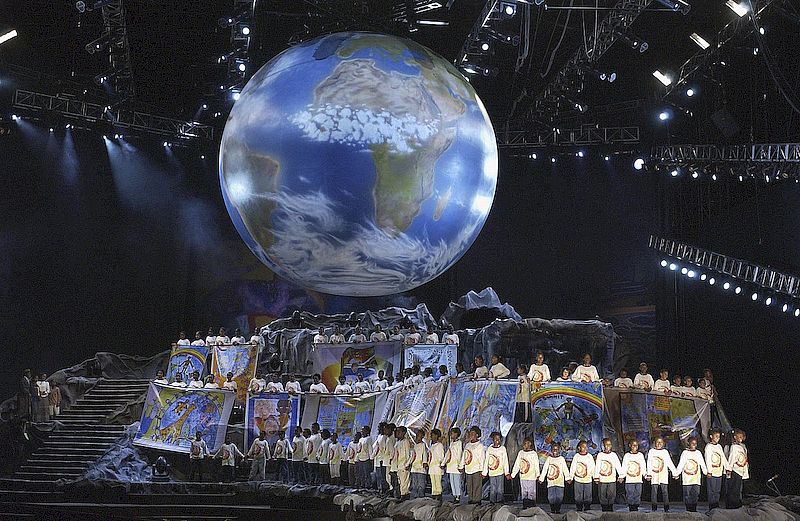
An event at the Rio conference
The 1990s were again a period of many possibilities, after the 1989-91 dramatic events had led to the end of the Cold War and the dissolution of the Soviet Union. In 1992 the United Nations called the nations of the world to a new summit, the UN Conference on Environment and Development (UNCED). It took place in Rio de Janeiro in June 1992, and became the largest conference ever organized. 179 governments were represented and 120 heads of state took part. Five documents were issued from the conference, a most important one being the Agenda 21, a 40-chapter document for the 21st century on how to achieve sustainable development, every bit of it carefully negotiated and agreed on. Now, sustainable development became mainstream policy in most countries in the world.
After the Rio Conference, a Commission for Sustainable Development (CSD) was established at the United Nations to lead the international work. A number of important developments followed, among them the Climate Convention, the establishment of the Global Environmental Facility to finance sustainability projects, and support of green business.
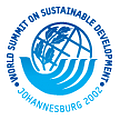 The next big meeting was the World Conference in Johannesburg, South Africa in 2002, ten years after Rio. It was the first UN conference where the phrase ‘sustainable development’ was in the name of the meeting. It did not become quite the same main event as the Rio conference. The most important document was its Plan of Implementation. The discussion was now about concrete details on how to work. Science and business were given main roles, the sustainable production and consumption patterns important, and education for sustainable development, ESD, another important point on the agenda. Just months later, the UN General Assembly decided on the decade for education for sustainable development to be 2005-2014 (see also: Chapter 5a: Sustainable Production and Consumption and Chapter 12a: Education for Sustainable Development.)
The next big meeting was the World Conference in Johannesburg, South Africa in 2002, ten years after Rio. It was the first UN conference where the phrase ‘sustainable development’ was in the name of the meeting. It did not become quite the same main event as the Rio conference. The most important document was its Plan of Implementation. The discussion was now about concrete details on how to work. Science and business were given main roles, the sustainable production and consumption patterns important, and education for sustainable development, ESD, another important point on the agenda. Just months later, the UN General Assembly decided on the decade for education for sustainable development to be 2005-2014 (see also: Chapter 5a: Sustainable Production and Consumption and Chapter 12a: Education for Sustainable Development.)
 In June 2012 the global society met in Rio again for the UN Rio+20 conference on sustainable development (UNCSD2012). This time the focus of the conference was green economy, reflecting that the economy is a top priority in most countries today and environmental concerns need to be included in economic development. The final document from Rio+20 is called The Future We Want, A main component is the agreement to develop as set of Sustainable Development Goals (SDGs). These are intended to follow the Millennium Development Goals (MDGs) and be a main focus in the UN work from 2015 when the MDG process ends.
In June 2012 the global society met in Rio again for the UN Rio+20 conference on sustainable development (UNCSD2012). This time the focus of the conference was green economy, reflecting that the economy is a top priority in most countries today and environmental concerns need to be included in economic development. The final document from Rio+20 is called The Future We Want, A main component is the agreement to develop as set of Sustainable Development Goals (SDGs). These are intended to follow the Millennium Development Goals (MDGs) and be a main focus in the UN work from 2015 when the MDG process ends.
Material for session 1b
Basic level
- Read The Road to Sustainability – The political history by Katarina Eckerberg. In: A Sustainable Baltic Region. Session 1.
- Watch Severn Cullis-Suzuki speaking at UN Earth Summit 1992 (YouTube Video)
- Watch Severn Cullis-Suzuki – A Call to Action for Canadians for Earth Summit 2012 (YouTube Video)
- Watch Maurice Strong's thoughts on Rio+20 in 2012 (YouTube Video)
- Read Environmental Science, chapter 23, pages 693-697: International Co-operation for the Environment.
Medium level (widening)
- Read Environmental Science chapter 23, pages 697-702: International Co-operation for the Environment
- Watch and listen to How NGO’s Can Get Involved in the Rio+20 Summit Process, Jan-Gustav Strandenaes (YouTube Video)
Advanced level (deepening)
Study in some detail the documents from the political process:
- Our Common Future – the report of the United Nations World Commission on Environment and Development also called the Brundtland Commission
- Agenda 21 and the other Rio documents
- The Johannesburg World Summit on Sustainable Development.
Additional Material
Sustainable Development Goals
The Future We Want
References
Rydén, L., Migula, P. and M. Andersson. 2003. Environmental Science – understanding, protecting, and managing the environment in the Baltic Sea region. Baltic University Press. Uppsala, Sweden.
Sörlin, S. (ed.). The Road Towards Sustainability. A Sustainable Baltic Region Session 1. Baltic University Press. Uppsala, Sweden.
1c.
Understanding sustainable development

The meaning of “sustainable development” should be kept simple: sustainability is a state which may continue in the long term, in fact forever. Sustainable development is a development, which brings us closer to sustainability. (Others consider sustainability and sustainable development to be the same thing.)
Sustainability normally refers to a system including not only society and people, but also nature or the environment. The system may be a city or a country, but today most often it is the whole world with everything on it, including nature, people, and our societies. For example, if someone talks about a sustainable economy, one may need to remind the person that the economy is part of a larger system and that it depends on all the component parts. One very often says that sustainable development has three dimensions, ecological (also called environmental), economic and social. However, these three parts of the system may be subdivided. Thus, the environment consists of the life forms, the atmosphere, the soil etc, while the social dimension may be divided into human welfare and society with all its institutions. It is obvious that the huge system under study has very many components.
The long term conditions required for sustainable development were used by the Brundtland Commission to create the most often used “definition” of sustainable development: “Sustainable development is development that meets the needs of the present without compromising the ability of future generations to meet their own needs”. It contains within it two key concepts:
- the concept of 'needs', in particular the essential needs of the world's poor, to which overriding priority should be given; and
- the idea of limitations imposed by the state of technology and social organization on the environment's ability to meet present and future needs.
One may see the Brundtland report as a diplomatic compromise between the concern of the Third World for development and the first world for environmental protection.
Understanding sustainable development is quite often a personal matter; these personal views have to be respected – what is important for one person or another may differ very much. Nevertheless, there are some basic conditions, which need to be fulfilled if a society should continue to prosper in the long term. These conditions may be divided into physical, biological, and social. The physical conditions are summarized in the Natural Step conditions for sustainable development, often used in practical work in business and at the local, the city, level. Here the proper use of resources and non-accumulation of pollutants are in focus. The biological conditions remind us about that we all depend on the sun as a source of energy, and that diversity of life forms need to be conserved to maintain life in the longer term. The social conditions for sustainable development have been less well studied. So far we may say that they refer to proper governance of societies, human welfare and a limited human population. (see also Chapter 11b: Implementing Sustainable Development)
An important condition for sustainability is not to rely on non-renewable resources (such as fossil fuels) or use renewable resources (such as fish) above their regeneration capacity. One may also underline that the human population need to stay within the carrying capacity of the environment. Sustainable development thus in practice often become the proper management of limited resources. (See also Session 3b: Limits to Growth)
The conditions thus reminds us that the interaction between the human realm and nature need to work properly. It includes both the fact that nature provides us with resources – air to breath, water to drink and food to eat – but that it also takes care of all the waste emitted from the human society. The capacity of Nature to do this should not be overused to guarantee long-term survival, that is, sustainability. Sustainability also requires that a society works properly, and that nature in itself also needs to work properly. All of this is illustrated in the list of collapsed and successful societies (See Chapter 1a: Stories of Societies Which Succeeded or Collapsed).
Material for session 1c
Basic level
- Read Environmental Science, chapter 25, pages 772-778: The Prospect of Sustainable Development or The Prospect of Sustainable Development (in Russian).
- Sustainable Development and Political Change. An interview with Gro Harlem Brundtland. (YouTube video).
Medium level (widening)
- Read Environmental Science, chapter 2, pages 64-65: How the Environment Works – Turnover of Matter and Energy.
- Read relevant parts of Environmental Science, chapter 3 and especially page 78: Ecology and Ecosystems.
Advanced level (deepening)
Compare the “definitions” of sustainable development used by different institutions.
- Brundtland Commission
- World Business Council for Sustainable Development
- The IUCN, published in their Caring for the Earth, 1990. Caring for the Earth: A Strategy for Sustainable Living
A more elaborate discussion on the concept of sustainable development by Robert W. Kates, Thomas M. Parris, and Anthony A. Leiserowitz, is found in the April 2005 issue of Environment: Science and Policy for Sustainable Development, Volume 47, No 3, pages 8–21.
DOI
References
Kates, R. W., Parris, T. M. and A. L. Leiserowitz. 2005. Environment Science and Policy for Sustainable Development, vol 47:3 pp 8 – 21.
Rydén, L., Migula, P. and M. Andersson (eds.). 2003. Environmental Science – understanding, protecting, and managing the environment in the Baltic Sea region. Baltic University Press, Uppsala, Sweden.
BUP Sustainable Development Course
1d.
What we believe in – Our values and sustainable development
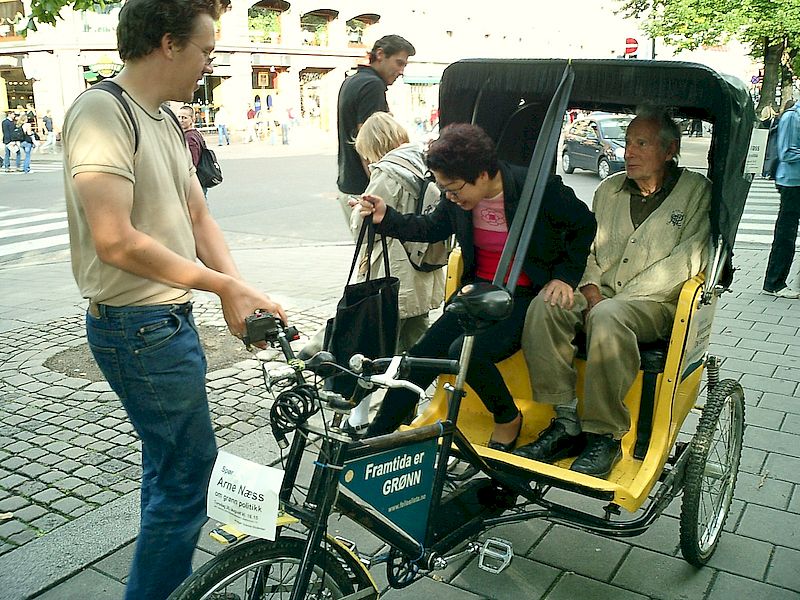
Professor Arne Næss founder of the deep ecology philosophy campaigning for the Norwegian Green party in 2003.
Sustainable development is not only a political and scientific concept. It is also a value. The Brundtland commission underlined that sustainability is an ethics for our future. In the 1987 report, they write: “We have attempted to demonstrate how human survival and well-being may be dependent on our capacity to successfully transform the principles behind sustainable development into global ethics.”
There are several parts in this ethics. The value dimension of sustainable development may be expressed in terms of justice.
Firstly, those who support, or work for, sustainable development with respect for the needs of coming generations. When we ask for justice between this and coming generations, we ask for intergenerational justice. The weak point with this request of justice is that the next generation is far away in time and space. This feeling of distance may be reduced by referring to the grandchildren, who already are here, or the fact that most people like the thought that what they have built up is preserved.
Sustainability is about sharing resources of our planet, not only between us and coming generations, but also between us living here and now. It is called intra-generational justice, justice between us here and now. The principle that each human being has the same right to resources is included in the Rio Declaration. For example, in the climate negotiations the long-term goal seems to be that the per capita emissions of carbon dioxide should then be the same everywhere. This is today very far from the reality, and the gap between the poor and the rich is increasing. The gross violation of this value is by many judged as the most serious of all threats to sustainable development.
 A third ethical principle of Sustainability is our obligations towards other life forms of the world, the animals, the plants, and the Nature in general. This is called bio-centric ethics or justice. Other life forms may not have duties towards us, but we have it towards them. The World Conservations Strategy, published by IUCN (International Union for the Conservation of Nature) in 1980 alarmed us about the rapid loss of biodiversity. The extinction of a number of life forms each year was seen as not only a problem for sustainable development, but also an ethical problem. We as humans do not have the right to “extinguish” these other forms of life. To this ethical statement are added concerns for resources, for the beauty of our world and the value of the natural world for coming generations. (See also: Chapter 6a: The living world)
A third ethical principle of Sustainability is our obligations towards other life forms of the world, the animals, the plants, and the Nature in general. This is called bio-centric ethics or justice. Other life forms may not have duties towards us, but we have it towards them. The World Conservations Strategy, published by IUCN (International Union for the Conservation of Nature) in 1980 alarmed us about the rapid loss of biodiversity. The extinction of a number of life forms each year was seen as not only a problem for sustainable development, but also an ethical problem. We as humans do not have the right to “extinguish” these other forms of life. To this ethical statement are added concerns for resources, for the beauty of our world and the value of the natural world for coming generations. (See also: Chapter 6a: The living world)
We see the role of ethics increasing in many contexts. Ethics motivate people to care for the world around them and change their lifestyles. Ethics is used to clarify the role of values in policy decisions and choosing among alternatives of action. In sustainable development, the role of values and ethics are often underlined. It needs to be transparent to help us to choose our future.
Material for session 1d
Basic level
- Read relevant parts of Environmental Science, chapter 21, especially pages 635-645: Behaviour and the Environment – Ethics, Education, and Lifestyle.
- Watch an interview with Prof William Hatcher (YouTube film).
- Watch an interview with Erwin Lazlo (YouTube film).
Medium level (widening)
- Read chapters 1, 2 and 3 by Mikael Stenmark in: A Sustainable Baltic Region, Session 9: Foundations of Sustainable Development
Advanced level (deepening)
- See the films and study the attached material on Global Responsibility (YouTube film).
- Study the Earth Charter Initiative and read the Charter as a development of ethics for sustainable living.
- Explore the concept of Gaia and deep ecology. Watch Dr. Stephan Harding – Part 1 / 10 – Gaia Theory & Deep Ecology (YouTube film).
References
Rydén, L., Migula, P. and M. Andersson (eds). 2003. Environmental Science – understanding, protecting and managing the environment in the Baltic Sea region. Baltic University Press. Uppsala, Sweden.
Stenmark. M. 1997. Foundations of Sustainable Development. In: A Sustainable Baltic Region. Session 9. Baltic University Press. Uppsala, Sweden.
BUP Sustainable Development Course
2a.
Energy supply and use

Chicago by night. CC BY-NC-ND 2.0 Photo: Lionel Tinchant.
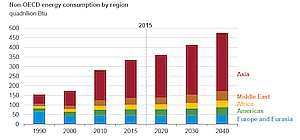 Energy is fundamental in our lives. Development and energy consumption in a society is typically parallel up to a point when energy use is levelling off, but then the energy consumption is already large. In Europe, it is close to 100 times our personal metabolic energy from the food, that is, the base for keeping alive. This is about 2.4 kWh/day, corresponding to an effect of 100 W. Still energy use differs much between countries and individuals, and also depends on methods for measuring it. Sweden uses each year about 400 TWh for 10 million inhabitants, industries and all kinds of societal needs.
Energy is fundamental in our lives. Development and energy consumption in a society is typically parallel up to a point when energy use is levelling off, but then the energy consumption is already large. In Europe, it is close to 100 times our personal metabolic energy from the food, that is, the base for keeping alive. This is about 2.4 kWh/day, corresponding to an effect of 100 W. Still energy use differs much between countries and individuals, and also depends on methods for measuring it. Sweden uses each year about 400 TWh for 10 million inhabitants, industries and all kinds of societal needs.
When discussing energy, it is useful to be acquainted with a few fundamentals. Energy is constant in the sense that it is not produced or consumed; it is only transformed from one kind to another, more or less useful for a purpose. Thus, a power station transforms energy stored in e.g. fossil carbon, or biomass, or high-level water, into electricity in a generator run by a turbine. The energy produced during a set time period is the effect of the power station. The usefulness of the energy – its capacity to do work – is called exergy. Electricity has 100% exergy, while the exergy of hot water or gas depends on its temperature: higher temperature means higher exergy.
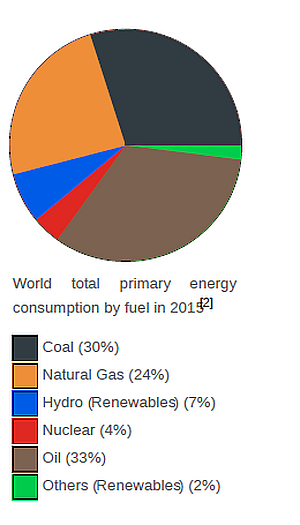 Energy can be stored as in fossil carbon or biomass, or flowing like in flowing water or in wind (flowing air) or the sun (flowing light). Stored energy functions as a fuel, while flowing energy is intermittent, it needs to be used directly. The transformation of intermittent energy into stored is a key difficulty for energy management. Hydropower has a unique capacity here as it can be stored as water in a dam on higher level. We will discuss energy in three forms: electricity (the best) heat (mostly hot water) and stored fuel. All of them can be quantified as Wh (Watt hours, other measures are also used) mostly expressed as kWh, MWh, GWh or TWh, using the prefixes, kilo, Mega, Giga or Tera for a thousand, a million, a billion and trillions.
Energy can be stored as in fossil carbon or biomass, or flowing like in flowing water or in wind (flowing air) or the sun (flowing light). Stored energy functions as a fuel, while flowing energy is intermittent, it needs to be used directly. The transformation of intermittent energy into stored is a key difficulty for energy management. Hydropower has a unique capacity here as it can be stored as water in a dam on higher level. We will discuss energy in three forms: electricity (the best) heat (mostly hot water) and stored fuel. All of them can be quantified as Wh (Watt hours, other measures are also used) mostly expressed as kWh, MWh, GWh or TWh, using the prefixes, kilo, Mega, Giga or Tera for a thousand, a million, a billion and trillions.
Today 85% of the global energy supply consists of fossil carbon: coal, oil and gas. This is not surprising considering that coal and oil has the highest concentration of energy we can imagine. Black coal has been used even from medieval times. The access to large amounts of oil from the 1860s and on led to rapid industrialization, urbanization and economic growth (Session 10a). The amounts of oil produced worldwide have increased ever since, especially with the discoveries of large oil fields in the Middle East. Oil is so good that the world has turned into oil addicts. It is thus a shock for countries that have relied on these sources of energy since even hundred of years to learn that they cannot continue burning fossil carbon as it leads to emissions of carbon dioxide, which cause climate change.
Coal, oil and gas are non-renewable resources and their use is unsustainable (See further Session 3a). This means that at some point in time its production will peak and then decline. This is called peak oil. It is much studied but difficult to predict as much data are hidden. For specific countries and fields it is, however, well known. Thus, US peak oil occurred in 1970 and the Norwegian peak oil was 1996-1999. Global peak oil occurs about now. Discovered oil fields have been declining since the 1960s. Of course the price of coal, oil and gas will increase when less is produced after the peak. Conventional oil will then be substituted for by unconventional, e.g. extracted from tar sand, or pumped from deep water, which will be more expensive, both in terms of energy to produce it and costs for producing it. Conventional oil peaked already about 2005.
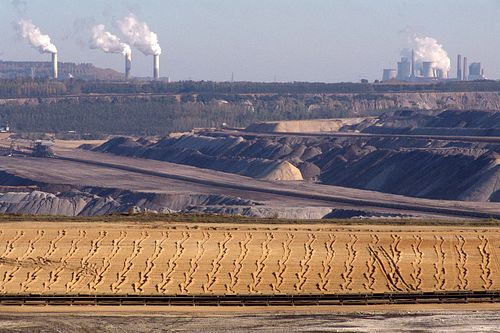
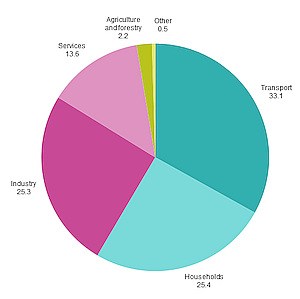 In most countries electricity are provided from power plants, most often using coal, lignite or natural gas as fuel. The fuel is incinerated to heat water, which is sent to a turbine which runs a generator producing electricity. This is not sustainable as it depends on fossil fuels. Power plants may be improved in two ways. By using the hot water from the turbines for district heating the plant (now CHP, Combined Heat and Power) increases the efficiency from about 39% to about 90%. Exchanging the fossil fuel for peat is an improvement, as is household waste, but best is to use biomass such as wood from energy forests or wood waste (roots, branches etc) to turn the power plant into a producer of renewable energy.
In most countries electricity are provided from power plants, most often using coal, lignite or natural gas as fuel. The fuel is incinerated to heat water, which is sent to a turbine which runs a generator producing electricity. This is not sustainable as it depends on fossil fuels. Power plants may be improved in two ways. By using the hot water from the turbines for district heating the plant (now CHP, Combined Heat and Power) increases the efficiency from about 39% to about 90%. Exchanging the fossil fuel for peat is an improvement, as is household waste, but best is to use biomass such as wood from energy forests or wood waste (roots, branches etc) to turn the power plant into a producer of renewable energy.
Nuclear power (NP) is not renewable for the simple reason that uranium is a fossil resource. Even if nuclear power plants can be safer and more efficient (3rd generation technology) than earlier, we are left with the problem of the nuclear waste, which remains toxic and radioactive for many thousands of years. It also appears that NP is too expensive for commercial investments and can only be built with governmental support. Very few NP plants are built today, although many are being planned. However, they do not emit carbon dioxide, which contributes to global warming, why many concerned scientists promote NP.
To become a sustainable society we need to change our energy regime completely and rely on renewable resources. Renewable energy resources all ultimately come from the sun. The sun makes the water move, the wind blow and the trees and plants grow. In one-way or the other a sustainable society needs to find out how to use the sun well and cleverly. And there is enough for all of us. Humankind uses about 0.1 per mille of the energy content of the sun coming to us every day and minute. Just as the ecosystems found in Nature depend on the sun for its survival, human society needs to do the same thing. To replace the large scale dependency on fossil fuels to renewable energy schemes is perhaps the most difficult part of a transition to sustainable societies.
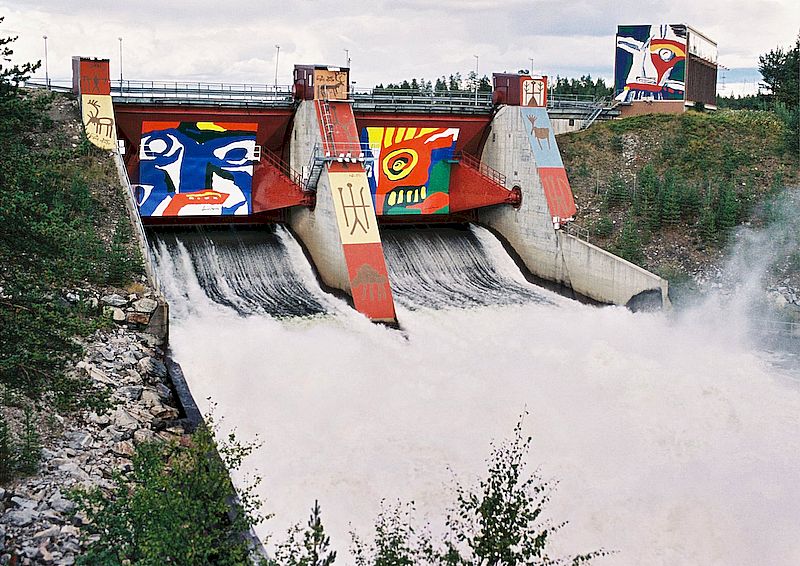 Akkats hydroelectric power plant in Swedish Lapland. Photo: Hans Blomberg
Akkats hydroelectric power plant in Swedish Lapland. Photo: Hans Blomberg
Renewable electricity is produced from hydropower plants, from wind power stations, and directly from solar cells, either photovoltaic, which directly transfers sunlight into an electric current, or from CSP, Concentrated Solar Power, in which the heat of the sun is focused to produce hot liquid producing electricity in a turbine. In the BSR hydropower is providing almost all of Norway’s electricity and 50 % of Sweden’s electricity, and a fair share in some of the other countries. Wind power is very important in Denmark (about 40% of electricity) and Germany. Solar cells are not big anywhere but increasing fast, by some 40% yearly. Other technologies include small hydropower plants, wave power at the coasts, electricity from running water, and electricity from power stations using renewable fuels such as biomass.
Renewable heat is important in many parts of the Baltic Sea region to heat our houses. Heating houses are mostly done using combustion. It may be in Eastern Europe most typically natural gas, but in the Nordic countries the earlier oil has been almost completely changed into biomass as wood: wood chips, or wood pellets, all renewable biomass. In district heating the houses in urban areas are connected to one common power plant. This is very much more efficient than a series of individual boilers, not the least because flue gases may be purified much more efficiently. Household waste incineration, the waste to energy step in waste management, takes care of waste and avoids landfill. This is seldom fossil fuel free as there is much plastic in household waste. It also requires good flue gas cleaning. Solar panels on the roof or larger size (municipal) may be used for solar heat. This is standard in Southern Europe. In the Baltic Sea region solar panels may heat houses and at best provide all hot water during March to October. Heat pumps use electricity to extract heat from ground or outdoor air. This is up to 4-5 times more efficient than direct electric heating and is renewable if the electricity is. Heat pumps are important in Sweden.
Renewable fuel is mostly biomass either as solid (wood), liquid or gas. This is most critical for road traffic, which today is almost entirely oil dependent. Bio-ethanol from fermentation of sugar, e.g. sugar beet (1st generation bio-ethanol), or cellulose after hydrolysis (2nd generation bio-ethanol) is renewable if produced in such a way. Today all petrol in the EU contains 5% ethanol; it may be increased to 10% without technical problems. Some cars and buses use E85 with 85% ethanol. Biodiesel is produced from oil crops, such as rapeseed, after extraction and methylation. It can easily replace standard diesel e.g. in buses and trucks. Production of biogas from anaerobic fermentation of organic waste (households, farms, wetlands etc) is increasing rapidly. In the Nordic countries it is mostly used for city buses. Biogas buses are more silent, less polluting and more sustainable. However transport is best done using electricity as it is about 4-5 times more efficient, less polluting, more silent and cheaper. The problem is the insufficient capacity of today’s batteries.
Materials for session 2a
Basic level
- Read A Sustainable Baltic Region, session 2, pages 5-10: Energy Use – For What?.
- Read Energy Production in the Rural Landscape In: Rural Development and Land Use.
- EU Energy Statistics 2017 edition see also EU Energy in Figures 2022.
- Read A Sustainable Baltic Region, session 2, pages 25-32: Environmental Effects of Energy Use in the Baltic Region.
- Climate Change Science and Impacts Factsheet, Center for Sustainable Systems, University of Michigan.
Medium level (widening)
- Read A Sustainable Baltic Region, session 2, pages 11-16: The Global context.
- Nordic Energy Solutions – A collection of projects on renewable energy in the Nordic countries, mostly by energy companies
- The European Commission Site on Energy contains information on all EU countries, the European energy strategy and a wealth of basic data.
Advanced level (deepening)
- Study in some detail one large commercial energy project:
Solar electricity from the Sahara Desertec
Gas pipeline in the Baltic Sea Nordstream
Lysekilsprojektet and wave power on the Swedish West coast - Read Environmental Management, book 2, chapter 6, pp 97-104: Energy Conservation
Additional materials
Livelihoods and climate change (addresses mostly the global south) from International institute of Sustainable Development (IISD).
References
Karlsson, I. and L. Rydén (eds.). 2012. Rural Development and Land Use. Ecosystem Health and Sustainable Agriculture: Book 3, Baltic University Press, Uppsala.
Nilsson, L., Persson, P. O., Rydén, L., Darozhka, S. and A. Zaliauskiene. 2007. Cleaner Production - Technologies and Tools for Resource Efficient Production Environmental Management Book 2, Baltic University Press, Uppsala.
Salay, J. (ed.) 1997. Energy – from fossil fuels to sustainable energy resources. In: A Sustainable Baltic Region, Session 2. Baltic University Press, Uppsala.
BUP Sustainable Development Course
2b.
Energy use and Climate change
The large scale combustion of fossil fuels, which have been going on since the beginning of industrialization around 1750, has led to massive emissions of carbon dioxide into the atmosphere. In addition, changes in land use, especially deforestation, have also contributed to large emissions of carbon dioxide. Estimations are that 1200 Giga tonnes of CO2 have entered the atmosphere in this way, almost all of it since 1900, and at a rate which is still increasing (about 32 Gt was emitted in 2008). Emitted carbon dioxide is partly dissolved in the world’s oceans. This reduces the content in the atmosphere, but also makes the ocean water more acidic. This is a threat to the world’s coral reefs and much marine biodiversity.
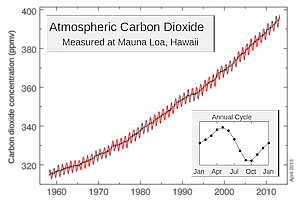 Atmospheric carbon dioxide concentration has been carefully monitored since 1958 at a research station in Hawaii. It was 392 ppm (parts per million) in 2011. The concentration has increased from pre-industrial levels of about 280 ppm. The contribution from fossil fuel combustion can be estimated from the C14 content of atmospheric CO2, since there is no C14 in the fossil carbon. Through measurements of ice cores from the Antarctica and other data, we have estimations of carbon dioxide concentrations in the atmosphere since about 800 000 years. At no time during this period it was as high as it is today.
Atmospheric carbon dioxide concentration has been carefully monitored since 1958 at a research station in Hawaii. It was 392 ppm (parts per million) in 2011. The concentration has increased from pre-industrial levels of about 280 ppm. The contribution from fossil fuel combustion can be estimated from the C14 content of atmospheric CO2, since there is no C14 in the fossil carbon. Through measurements of ice cores from the Antarctica and other data, we have estimations of carbon dioxide concentrations in the atmosphere since about 800 000 years. At no time during this period it was as high as it is today.
Carbon dioxide is a Greenhouse Gas (GHG) and contributes to the so-called enhanced greenhouse effect of the atmosphere. Carbon dioxide absorbs heat and radiates it back, and thus increases the temperature of the planet. A greenhouse effect has already increased the planet temperature some 35 degrees due to already present GHGs (mostly water) that is why the effect caused by CO2 is called “enhanced”.
Other greenhouse gases which contribute to the enhanced greenhouse effect, include methane with 21 times higher radiative forcing than CO2, nitrous oxide N2O, and CFCs also called freons. Even if these three GHGs, also emitted from society, have a much larger effect, they are emitted in smaller volumes and have a shorter half-life in the atmosphere (they are broken down to CO2 and other components). Thus, CO2 with a very long half-life is the most serious one. If all GHGs are included according to their contributions recalculated as CO2 equivalents, we have today about 420 ppm CO2e (e stands for equivalent).
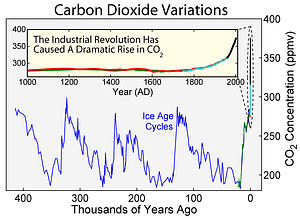 The Climate of our Earth is of extreme importance to all life. It is studied by Climate sciences. The global temperature is the result of a balance between several factors. Basic is solar irradiation to the planet and heat radiation from the planet, but these simple factors are modified by several other parameters. Clouds increases temperature, snow and ice cover reflects sun (the albedo effect) and reduce temperature, while GHGs increases temperature. There is a variation of sun irradiation due to sun cycles and astronomic parameters (e.g. resulting in ice ages), a contribution from geothermal heat due to radioactive decay, and reduction of sunlight by volcanic ash after eruptions etc. Temperature distribution is critical for precipitation patterns, and the amount of water bound in glaciers decides ocean water sea levels.
The Climate of our Earth is of extreme importance to all life. It is studied by Climate sciences. The global temperature is the result of a balance between several factors. Basic is solar irradiation to the planet and heat radiation from the planet, but these simple factors are modified by several other parameters. Clouds increases temperature, snow and ice cover reflects sun (the albedo effect) and reduce temperature, while GHGs increases temperature. There is a variation of sun irradiation due to sun cycles and astronomic parameters (e.g. resulting in ice ages), a contribution from geothermal heat due to radioactive decay, and reduction of sunlight by volcanic ash after eruptions etc. Temperature distribution is critical for precipitation patterns, and the amount of water bound in glaciers decides ocean water sea levels.
An increase of the temperature of Earth due to the massive emissions of carbon dioxide has been predicted since long. We also observe that the planet is getting warmer. Compared to average temperature during the first half of 20th century, we have globally about 0.8 degrees warmer climate today. The 13 warmest years recorded have occurred during the last 15 years. This extra heat is not distributed equally on the planet. In general, the far north and south have a larger climate effect. The higher CO2 concentration in the atmosphere is expected to result in at least 2 degrees warming by mid-century, and up to 4 degrees warming by the end of the century. This will have dramatic consequences. (Compare the temperature difference between an ice age and the present, which is about 5 degrees.)
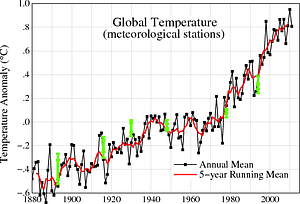 Global warming has a number of effects, many of them already observed and some expected in the future. Extreme weather events will be stronger and come more often. This includes heat waves, tornados, hurricanes, storm, floods and draughts. In general, wet areas will be wetter and dry areas drier. The social, economic and environmental consequences of these are serious. Thus, the particularly hot year of 2003 in Europe had an additional 30 000 casualties due to heat. Agriculture will change, and harvests decrease in some areas (and increase in others). Hurricanes, storm, and floods in densely inhabited areas destroy infrastructure and property for immense values.
Global warming has a number of effects, many of them already observed and some expected in the future. Extreme weather events will be stronger and come more often. This includes heat waves, tornados, hurricanes, storm, floods and draughts. In general, wet areas will be wetter and dry areas drier. The social, economic and environmental consequences of these are serious. Thus, the particularly hot year of 2003 in Europe had an additional 30 000 casualties due to heat. Agriculture will change, and harvests decrease in some areas (and increase in others). Hurricanes, storm, and floods in densely inhabited areas destroy infrastructure and property for immense values.
Global warming can also be noted as reducing glaciers all over the planet, the melting of the Arctic winter ice, melting of the ice gap of Greenland and reduced glaciations of Antarctica. As all this ice become ocean water, the sea level is expected to increase by some 1–2 meters above present at the end of the 21st century. The Arctic summer ice may be gone by 2035, and the Canadian Arctic Ocean coast, the Northwest Passage, start to be used for ship transport.
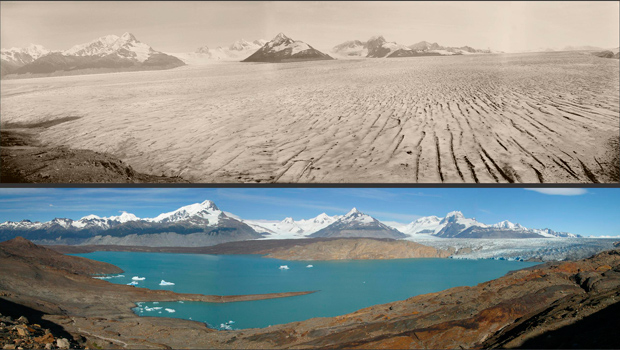
There will also be large consequences for ecosystems, which all are very climate dependent. Thus, warmth-craving southern species (including insects being vectors for diseases) will move north while northern species (e.g. polar bears) become marginalized or disappear. Some of these effects are already painful. Crops have to be adapted to a different climate and in some areas' irrigation will be problematic.
Climate scientists build models of climate and climate change, assuming different scenarios for future developments. Although observing the ongoing changes do not need any models, we need models for understanding causes and predicting future changes. These models predict a very dramatic development if not emission of carbon dioxide and other GHGs ends. Especially they are concerned with so-called positive feed-backs, e.g. when ice cover reduces there will be less albedo (reflection) and this will increase temperature. Melting the Siberian permafrost releases large volumes of methane, which is a strong GHG. A number of such feedbacks have been identified. The models can to an extent predict changing temperatures and precipitation on the regional level. The Baltic Sea region is in a fairly good situation, although e.g. the environmental problems of the Baltic Sea are likely to get worse.
The public debate on global warming has been intense for many years, and those denying what have been described here have had a large exposure. These climate deniers either deny that there is a global warming at all, or that this warming is due to what we did in society (especially combustion of fossil fuels) and argue that there are other reasons, such as increased solar radiation. These opinions are typical for non-scientists, at least non-climatologists. Among the experts, e.g. in the research literature, there are only very few among thousands who question the established picture, even if in some cases there may be good reasons to do so. For examples, data on historical temperatures and carbon dioxide concentrations are all indirect and can be interpreted differently, but the picture described above has support from a large majority. Among non-scientists, it appears that especially those who are facing and not prepared to accept the very threatening consequences of the global warming take denial as a way out.
Obviously, the costs for the damages caused by extreme weather events are tremendous. From this point of view, it would be better to invest in mitigation (reducing climate change) than paying for the consequences. The respected World Bank economists Sir Nicholas Stern after an extensive expert study reported to the British government on the costs of climate change and the costs of mitigation and estimated that 1% of the GDP should be used for mitigation measures, rather than waiting for higher costs for impacts later on. The world has not followed his advice.
Materials for session 2b
Basic level
- Read the introductory part of the Intergovernmental Panel for Climate Change, IPCC, 4th assessment report. See also the Sixth Assessment Report.
- European Environmental Agencies report on global temperature changes.
- The Climate Change Collection in Encyclopedia of the Earth.
- Wikipedia: List of CO2 emissions by country.
- How Do Carbon Dioxide Concentrations in the Atmosphere Affect Global Climate? Part I, Part II, Part III (YouTube films)
- Watch 131 Years of Global Warming in 26 Seconds (Climate Central Video), see also Global Change 1850 - 2020 (YouTube film)
Medium level (widening)
- Read on Climate modelling at the website of National Oceanic and Atmospheric Administration (NOAA).
- Read on the effects of Climate Change (IPCC, 5th AR).
- Look at how science is responding to the arguments of the so-called sceptics.
- Look at how sceptics are responding to the arguments of science.
Advanced level (deepening)
- The Stern Report on the economic costs of climate change.
References
Intergovernmental Panel on Climate Change 2007. Climate Change, 2007 - The Physical Science Basis: Working Group I Contribution to the Fourth Assessment Report of the IPCC.
Intergovernmental Panel on Climate Change 2007. Climate Change 2007 - Impacts, Adaptation and Vulnerability: Working Group II contribution to the Fourth Assessment Report of the IPCC
Intergovernmental Panel on Climate Change 2007. Climate Change 2007 - Mitigation of Climate Change: Working Group III contribution to the Fourth Assessment Report of the IPCC.
Stern, N. 2007. The Economics of Climate Change: The Stern Review.
Sida 5 av 15
